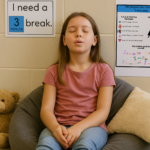

You’ve put in the work. Your rules and expectations are clear, your routines and procedures are consistent, and your classwide reinforcement system is running smoothly. You’re using positive reinforcement, consistent corrective responses to problem behaviors, and proactive strategies to create a structured and supportive environment.
But even with all that in place, there are still a few students who just aren’t responding. You’re redirecting the same behaviors over and over. They’re still avoiding work, calling out, getting up at the wrong times, or disrupting lessons. No matter how much structure and reinforcement you provide, something still isn’t clicking for them.
So what do you do when your solid classroom management plan isn’t cutting it? That’s where Tier 2 interventions come in.
Tier 1 strategies (your classroom management plan) work for most students—but some need extra support. Here’s how you know it’s time to level up your approach:
If this sounds familiar, your student may need Tier 2 interventions—structured, research-backed strategies designed to provide targeted behavior support.
Tier 2 interventions go beyond general classroom management and focus on students who need extra support to succeed. They’re more individualized, more structured, and proactive rather than reactive.
Some of the most effective Tier 2 strategies include:
If you’re ready to try something right now, here are a few simple Tier 2 strategies you can implement today:




These are quick, low-prep strategies that can make a big difference in how students respond to your interventions.
If you’re feeling stuck or overwhelmed, my Quick Guide to Tier 2 Behavior Interventions has even more strategies to help you support students effectively. This guide is designed for busy teachers who need clear, easy-to-implement strategies that actually work.





You don’t have to figure this out on your own. With the right tools, you can support your students without feeling like you’re constantly putting out fires.

Classroom management is important—but for some students, it’s just not enough. And that’s okay! The key is knowing when to move beyond Tier 1 and into more structured support. With the right Tier 2 interventions, you can help your students thrive without feeling like you’re drowning in behavior challenges.
I know how hard you’re working to support your students, and I want you to know—you’re not alone. Keep going, you’re making a difference every single day!

The Behavior Bestie